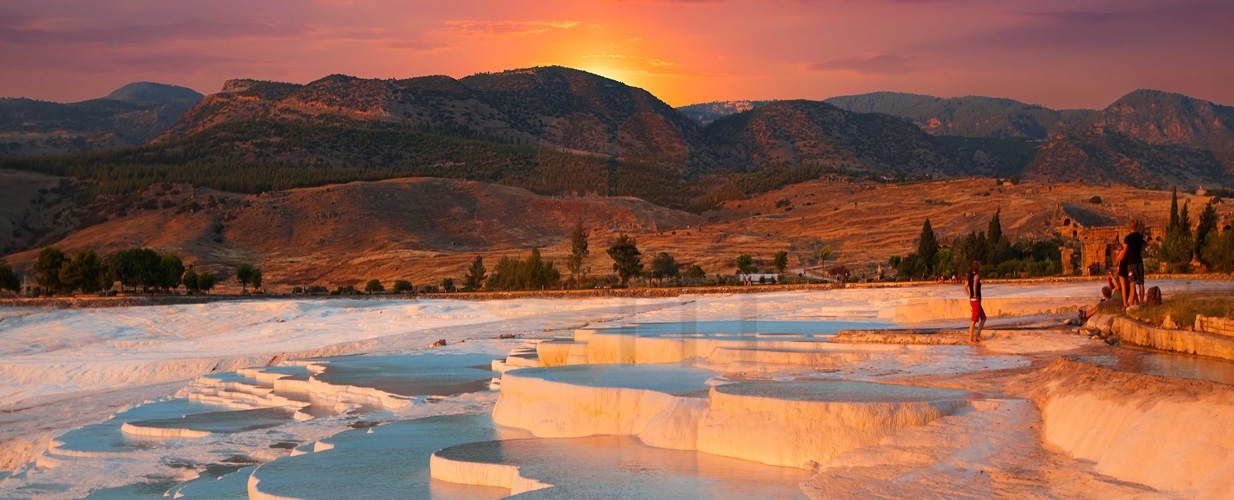
Pamukkale
Pamukkale is a unique natural wonder located in southwestern Turkey. The name “Pamukkale” translates to “Cotton Castle” in Turkish, which perfectly describes the surreal landscape found there. It is renowned for its stunning white terraces of travertine, which are formed by mineral-rich thermal waters flowing down the slopes.
The terraces of Pamukkale were created over thousands of years as calcium carbonate-rich waters from the hot springs in the area deposited minerals and solidified. This process resulted in the formation of dazzling white terraces that cascade down the hillside. The terraces, with their pools of turquoise water, give the appearance of a cotton-like castle, hence the name.
In addition to the terraces, Pamukkale is also home to the ancient Roman city of Hierapolis, which was built on top of the terraces. Hierapolis was once a thriving city and a popular spa destination in the Roman Empire. Today, visitors can explore the remarkably preserved ruins of Hierapolis, including its ancient theater, necropolis (cemetery), and Roman bathhouses.
One of the main attractions in Pamukkale is the opportunity to bathe in the thermal waters. The warm mineral-rich waters are believed to have healing properties and have been used for centuries for their therapeutic effects. Visitors can walk on the terraces, dip their feet in the pools, or even swim in the designated areas.
Pamukkale is a UNESCO World Heritage Site and is protected to preserve its natural and cultural significance. To maintain its pristine condition, visitors are asked to remove their shoes when walking on the terraces to prevent damage. There are also designated paths to follow to minimize impact.
Getting to Pamukkale is relatively easy, as it is located near the town of Denizli. The nearest airport is Denizli Çardak Airport, which has domestic connections within Turkey. From there, it is a short drive to Pamukkale.
Overall, Pamukkale offers a unique and breathtaking experience, combining natural beauty with ancient history. It is a must-visit destination for those traveling to Turkey, providing a remarkable blend of natural and cultural wonders.
Pamukkale Terraces and Travertines
The main attraction of Pamukkale is its stunning white terraces and travertines formed by the flow of mineral-rich water over thousands of years. The terraces resemble cascading white cotton or frozen waterfalls, creating a surreal and picturesque landscape.
Pamukkale Hot Springs and Thermal Pools
Pamukkale’s terraces are filled with thermal waters that are believed to have healing properties. Visitors can walk barefoot on the terraces and enjoy the warm, mineral-rich water. Some of the terraces have been converted into thermal pools where you can relax and rejuvenate.
Hierapolis
Hierapolis was an ancient city located in southwestern Turkey, near the modern town of Pamukkale. The city was founded in the 2nd century BC by the King of Pergamon, and it thrived as a major cultural and thermal spa center during the Hellenistic, Roman, and Byzantine periods.
Hierapolis was built on top of the white terraces of Pamukkale, taking advantage of the natural hot springs in the area. The city became renowned for its healing waters, and people would travel from far and wide to enjoy the therapeutic benefits of the thermal baths. The water, rich in minerals, was believed to have healing properties for various ailments.
The city flourished under Roman rule, and many grand buildings and structures were erected during this time. The extensive ruins of Hierapolis that can be seen today include:
The theater of Hierapolis
The theater of Hierapolis is one of the best-preserved ancient theaters in Turkey. It could accommodate around 15,000 spectators and was used for theatrical performances and gladiator contests.
Necropolis: Hierapolis had an extensive necropolis or cemetery, which is famous for its well-preserved tombs and sarcophagi. The necropolis stretches for several kilometers and offers a glimpse into the burial customs of the ancient city.
Roman Baths of Hierapolis
Hierapolis had several Roman bath complexes that were an integral part of the city’s spa culture. The baths featured hot, warm, and cold pools, as well as various rooms for relaxation and socializing.
The Temple of Apollo
The Temple of Apollo was a prominent religious structure in Hierapolis. Although it is not well-preserved today, its ruins can still be seen, and the site offers a scenic view of the surrounding area.
The Plutonium
The Plutonium was a sacred cave believed to be the entrance to the Underworld. It emitted toxic gases, and it was considered a place of religious significance in ancient times.
These are just a few highlights of the archaeological site in Hierapolis. Exploring the ruins allows visitors to gain insight into the city’s history, architecture, and the daily lives of its inhabitants. The site is recognized as a UNESCO World Heritage Site and is an important cultural and historical attraction in Turkey.
Pamukkale Cleopatra’s Pool
Within the Hierapolis archaeological site, there is a unique pool known as Cleopatra’s Pool (also called the Antique Pool). It is believed that Cleopatra herself swam in this pool, and it contains ancient Roman ruins. Visitors can swim in the mineral-rich waters surrounded by ancient columns and remnants.
Hierapolis Archaeological Museum
To learn more about the history and culture of the region, you can visit the Hierapolis Archaeological Museum. The museum displays artifacts excavated from the Hierapolis site, including statues, mosaics, and everyday objects, providing insights into the ancient city’s past.
Pamukkale Sunset Point
For breathtaking views of Pamukkale and the surrounding countryside, head to Sunset Point, located above the terraces. This vantage point offers a panoramic vista, especially during the golden hour when the setting sun casts a warm glow on the landscape.
Pamukkale is a popular tourist destination from Marmaris, and it’s important to respect the site’s natural beauty and historical significance. Visitors are advised to follow the designated pathways and avoid damaging the travertines. Additionally, remember to bring appropriate footwear, sunscreen, and drinking water when exploring the terraces.
Because of the glorious white travertine and historical value of Hierapolis Ancient City Pamukkale was added to the UNESCO World Cultural Heritage in 1988.
